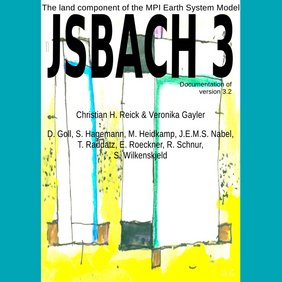Under the auspices of Erich Roeckner, the first step was the technical separation of land processes from atmospheric processes in ECHAM. The first elements of the land carbon cycle (photosynthesis, phenology, carbon storages for plants and soils) were completed in 2004 and participation in the international C4MIP simulations [1] demonstrated that MPI-M now successfully advanced from the forefront of climate modelling to the forefront of Earth System modelling. With Martin Claussen becoming director of the newly founded department “The Land in the Earth System” in 2005, JSBACH continuously grew in complexity by adding e.g., components for anthropogenic and natural changes in biogeography. Since then, JSBACH has been used in numerous studies, either 'offline' as separate land component, or 'online' as part of MPI-ESM (see publication list at [2]).
Ever since the first lines of code, a documentation was under development but writing could not catch up with the pace of model development. With the advent of ICON-ESM, however, the development of MPI-ESM largely came to a halt, and this was the chance to finish the documentation that, after almost 20 years of JSBACH development, has now been finally published in our institute-owned series "Reports on Earth System Science" [3]. Documented is version 3.2, which is the final version of the MPI-ESM development line. But this doesn't mean that the documentation is already outdated at the time of its appearance: MPI-ESM is still part of the core science at MPI-M. Moreover, the successor JSBACH 4, the land component of ICON-ESM, includes process descriptions largely identical with JSBACH 3, so that the documentation comes just right to be, for quite a while, the key information source also on this newly developed JSBACH.
Publications:
[1] Friedlingstein et al. (2006): Climate-carbon cycle feedback analysis: Results from the C4MIP model intercomparison.
Journal of Climate 19, 3337-3353 (2006). http://doi.org/10.1175/JCLI3800.1
[2] JSBACH publications: https://mpimet.mpg.de/en/science/the-land-in-the-earth-system/working-groups/global-vegetation-modelling/jsbach-publications
[3] Reick, C., Gayler, V., Goll, D., Hagemann, S., Heidkamp, M., Nabel, J., Raddatz, T., Roeckner, E., Schnur, R. & Wilkenskjeld, S. (2021) "JSBACH 3 - The land component of the MPI Earth System Model: Documentation of version 3.2". Berichte zur Erdsystemforschung, 240, https://doi.org/10.17617/2.3279802
Contact:
Dr Christian Reick
Max Planck Institute for Meteorology
Phone: +49 (0)40 41173 117
Email: christian.reick@mpimet.mpg.de
Dr Veronika Gayler
Max Planck Institute for Meteorology
Phone: +49 (0)40 41173 138
Email: veronika.gayler@mpimet.mpg.de
Dr Reiner Schnur
Max Planck Institute for Meteorology
Phone: +49 (0)40 41173 379
Email: reiner.schnur@mpimet.mpg.de

